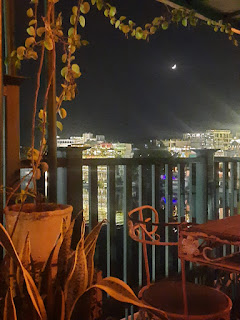Yakshagana, the enchanting folk art of Karnataka
Namaskara everyone! The curious Aai (आई), mama as they call in English and Thayee (ತಾಯಿ) in Kannada, is back with a story about a different experience that she had recently! This time it's not about a place but a traditional folk art from the coastal part of Karnataka, the Yakshagana (ಯಕ್ಷಗಾನ/यक्षगान). Recently I watched a Yakshagana performance as a part of women's day celebration program organized by Swakruta and Maharashtra Mandal Bangalore. My visit to Janapadaloka, which hosts compelling statues of various folk forms of Karnataka, introduced me to the same, but I had never witnessed a performance.
 |
| Yakshagana statues at Janapadaloka |
Being accompanied by my five-year-old, I was a little doubtful about attending the 1.5 hour long show. But, as Mr. Phatak, Bhagawatar (the orchestrator of the act) started singing Naandi (नांदी/ನಾಂದಿ; an invocation of gods seeking successful completion of the act) in his orotund voice, accompanied by a dancer depicting Ganapati, we were deeply enthralled.
Naandi was followed by the main performance. It was based on the Shurpanakha's story in the great epic of Ramayana. Courteous, genteel as well as restrained Rama, and dutiful Lakshmana were portrayed aptly by the artists.
 |
| Rama and Lakshmana with Sadhus requesting for their help to fight demons |
The character that really stole the show was that of Shurpanakha. What an amazing performer she was! She so skillfully showed the minutiae of the character. The Shurpanakha, excited by the smell of a human prey, falling in love with Rama, hatching the plan of tricking him into a marriage and eventually being aggrieved by Lakshmana who cuts her nose. The character of Shurpanakha after disguising as a young and beautiful noblewoman, was played by another lady who performed the role very skillfully.
 |
| Shurpanakha |
I loved the use of subtle variations in the get up to show the essential attributes of the characters, like gender, heroism/demonism etc. Look at Ravana's character, how lively it is!
I salute these artists who are committed to preserving such a great art form in today's magnificently sophisticated and spiritually bankrupt world (as described by Mr. Abatcha Umar). I can barely imagine the amount of effort that must have gone behind creating this captivating act.
We as Indians have got such a rich heritage! If we invest in reviving it and repackaging it to suit the modern world without losing the gist, the sky will be the limit to our success. Isn't the success of Kantara illustrative enough? Blindly investing ourselves in foreign things is a way of attracting yet another episode of slavery. Let's learn from the history. Let's wake up, invest in our heritage and enjoy the prerogative that comes with it.
I will end this post with a quote by Mr. Nelson Mandela,
"Our rich and varied cultural heritage has a profound power to help build our nation"
Here are a couple of interesting podcasts that are vaguely related to this thought:



Comments
Post a Comment